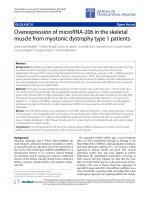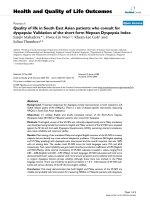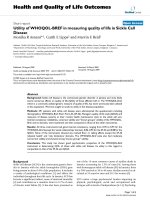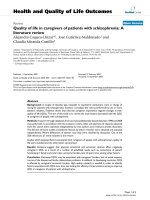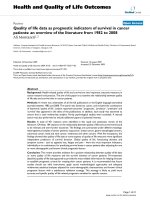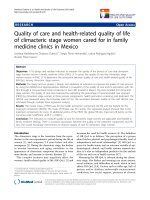báo cáo hóa học:" Quality of data collection in a large HIV observational clinic database in sub-Saharan Africa: implications for clinical research and audit of care" docx
Bạn đang xem bản rút gọn của tài liệu. Xem và tải ngay bản đầy đủ của tài liệu tại đây (242.29 KB, 7 trang )
RESEARCH Open Access
Quality of data collection in a large HIV
observational clinic database in sub-Saharan
Africa: implications for clinical research and
audit of care
Agnes N Kiragga
1*
, Barbara Castelnuovo
1
, Petra Schaefer
1,2
, Timothy Muwonge
1
, Philippa J Easterbrook
1
Abstract
Background: Observational HIV clinic databases are now widely used to answer key questions related to HIV care
and treatment, but there has been no systematic evaluation of their quality of data. Our objective was to evaluate
the compl eteness and accuracy of recording of key data HIV items in a large routine observational HIV clinic
database.
Methods: We looked at the number and rate of opportunistic infections (OIs) per 100 person years at risk in the
24 months following antiretroviral therapy (ART) initiation in 559 patients who initiated ART in 2004-2005 and
enrolled into a research cohort. We compared this with data in a routine clinic database for the same 559 patients,
and a further 1233 patients who initiated ART in the same period. The Research Cohort database was considered
as the reference “gold standard” for the assessment of data accuracy. A crude percentage of underreporting of OIs
in the clinic database was calculated based on the difference between the OI rates reported in both databases.
We reviewed 100 clinic patient medical records to assess the accuracy of recording of key data items of OIs, ART
toxicities and ART regimen changes.
Results: The overall incidence rate per 100 person years at risk for the initial OI in the 559 patients in the research
cohort and clinic databases was 24.1 (95% CI: 20.5-28.2) and 13.2 (95% CI: 10.8-16.2) respectively, and 10.4 (95% CI:
9.1-11.9) for the 1233 clinic patients. This represents a 1.8- and 2.3-fold higher rate of events in the research cohort
database compared with the same 599 patients and 1233 patients in the routine clinic database, or a 45.1% and
56.8% rate of underreporting, respectively. The c ombined error rate of missing and incorrect items from the
medical records’ review was 67% for OIs, 52% for ART-related toxicities, and 83% and 58% for ART discontinuation
and modification, respectively.
Conclusions: There is a high rate of underreporting of OIs in a routine HIV clinic database. This has important
implications for the use and interpretation of routine observational databases for research and audit, and highli ghts
the need for regular data validation of these databases.
Background
Prospective research cohorts of HIV-infected persons have
made a major contribution to an understanding of the
transmission, natural history and pathogenesis of HIV
infection [1-3], in addition to generating important
information on the response to and long-term outcomes
with antiretroviral therapy (ART). Distinctive features of
these research cohorts are their voluntary enrolment of
select ed eligi ble patients, prospective follow up and stan-
dardized data collection at regular defined time points.
Their principal disadvantages a re that they are costly to
establish and maintain, tend to study selected populations,
and may be poorly representative of the demography and
* Correspondence:
1
Research department, Infectious Diseases Institute, P.O. Box 22418 Kampala,
Uganda
Full list of author information is available at the end of the article
Kiragga et al. Journal of the International AIDS Society 2011, 14:3
/>© 2011 Kiragga et al; licensee BioMed Central Ltd. This is an Open Access article distributed under the terms of the Creative Commons
Attribution License ( which permits unrestricted use, distributio n, and reproduction in
any medium, provided the original work is properly cited.
outcomes of the majority of patients currently receiving
ART.
As a result, over the past decade, there has been a
major shift towards the use of local or regional observa-
tional HIV clinic databases to answer key questions
related to HIV care and treatment. These are usually
based on unselected patients in care at a single clinic or
across multiple clinics, and use data collected during the
routi ne delivery of HIV care [ 4-6]. Their key adv antages
are that they are generally large and representative,
since they are based on all patients in care, and involve
minimal additional resources as a result of using routi-
nely collec ted data. Their principal limitations are miss-
ing, incomplete or inaccurate data due to either visit
schedules v arying according to patient need, or to fail-
ures in either data collection or data entry. Although
some of these databases have quality assurance and
auditing programmes [4,7], there has been no systematic
evaluation of the quality of data in these now widely
used HIV observational databases in different clinical
settings.
The Infectious Diseases Institute (IDI) in Kampala,
Uganda, is a centre of excellence for HIV clinical care in
the c ountry, and maintains a large observational clinic
database and a nested research cohort database on HIV-
1-infected patients register ed for care. Our objective was
to assess the quality of data collection in a large HIV
observational routine clinic database by evaluating the
completeness and accuracy of recording several key da ta
items, including opportunistic infections (OIs), ART
drug toxicities, and reason s for ART regimen change or
discontinuation.
Methods
Clinic database
From 1 January 2000 to 31 December 2007, 19,577
HIV-infected patients had registered for care at IDI, of
whom 13,099 remained in active follow up a nd 6421
had started ART. We focused on the subgroup of 1792
clinic patients who initiated ART over the p eriod,
1 April 2004 to 30 April 2005. Of these, 559 patients
were also consecutively enrolled into a nested research
cohort, and 1233 patients received care through the rou-
tine clinic alone.
The electronic capture of all information onto the clinic
database began in November 2005. Key data items
recorded by clinicians at monthly follow-up visits
included: OIs, ART regimen, ART toxicities, and reasons
for treatment modification. Full blood count and CD4+
T cell count tests were performed every six months; HIV-
RNA measurements were not performed routinely, but
could be requested when treatment failure was suspected.
At IDI, clinic antiretroviral treatment is prescribed
according to World Health Organization (WHO) 2006
and Uganda Ministry of Health guidelines [8]. The first-
line ART for adults and adolescents is sta vudine or
zidovudine, plus lamivudine, and nevirapine or efavirenz.
On average, 350 patients were seen daily by 10 to 15
physicians. In addition to recording details of the clinic
visit in the patients’ medical record, the selected data
items were also recorded by the physician on a clinic
monitoring summary s heet, from which they were
entered by a data administr ator into an electro nic
database.
Research cohort
From 1 April 2004 to 30 April 2005, in the initial p hase
of t he ART rollout in Ugan da, 1792 patie nts registered
at IDI were eligible for ART initiation. Of these, 559
were consecutively enrolled into a prospective research
cohort. Reasons for not enrolling in the research cohort
included patient refusal or various exclusion criteria e.g.,
residing more than 8 km from IDI, and previous ART
exposure.
Research study visits took place every three months, in
addition to the routine monthly clinic visits. The data
items collected were similar to those at the routine
clinic visits, but standardized data collection forms were
used, and there was additional information collected on
sexual behaviour, adherence and quality of life. On aver-
age, about 15 research cohort patients were seen daily
by two trained study physicians, and data were entered
into a separate research cohort database by a dedicated
research clerical team. Full details of the research cohort
study procedures have been described previously [9].
All research participants had data from their monthly
routine clinic visits recorded on the routine clinic data-
base, but data collected at research visits on patients
co-enrolled in both the clinic and the research cohorts
were not entered onto the clinic database. All CD4 cell
counts for both the research and routine clinic patients
were carried out by a single laboratory: Makerere Uni-
versity-Johns Hopkins Uganda collaboration laboratory,
which is accredited by the College of American
Pathologists.
Outcomes and statistical analyses
We compared the baseline demogr aphic and clinical
characteristics at ART initiation for the 559 patients
enrolled into the Research Cohort study with the 1233
patients who were initiated on ART between 1 April
2004 and 31 April 2005, but were not enrolled into the
research cohort. Categorical variables were compared
using Chi-square test, while the Mann-Whitney test was
used for the continuous variables [10]. We also exam-
ined the baseline characteristics in all 6421 patients who
had ever initiated ART at IDI to assess how representa-
tive our study populations were of all patients on ART.
Kiragga et al. Journal of the International AIDS Society 2011, 14:3
/>Page 2 of 7
We calculated incidence rates of OIs per 100 person
years at risk (100 PYAR), where duration of follow up
was based on time from ART initiation to date of devel-
opment of OI or death, or date of their last clinic or
research cohort study follow-up visit closest to
24 months (731 calendar days), if the patient was not
under “active” follow up [10]. For the patients who were
still under follow up as of December 31 2007, the date
of their last routine clinic visit closest to 24 months of
follow up or at the 24-month visit in the research
cohort was used. The overall incidence rate for all initial
OIs, and for each OI, was calculated.
We undertook two different comparisons of the rate
of OIs in the first 24 months following ART initiation
with the reference “gold standard ” research cohort data-
base to determine the completeness and accuracy of key
data items recorded in t he routine clinic database. First,
we compared the OI rate for the 559 patients in the
routine clinic database with their records in the research
cohort database (Comparison A). The second analysis
(Comparison B) compared the 1233 patients in the rou-
tine clinic database with the 559 patients in the research
cohort database in order to assess t he level of underre-
porting in a larger number of patients in the clinic data-
base who were not part of a research study.
For each analysis, we compa red the overa ll incidence
rates of the initial OI, and then the rate for the nine
most common OIs individually. These included tubercu-
losis, severe bacterial pneumonia, herpes zoster, oral and
oesophageal candidiasis, cerebral toxoplasmosis, Crypto-
coccus meningitis, genital herp es, Kaposi’s sarcoma and
an “other OI” category (Pneumocystis jirovecii pneumo-
nia, CMV retinitis, lymphoma, HIV-related anaemia,
septicaemia, chronic diarrhoea, intracerebral mass, and
pulmonary aspergillosis).
A crude p ercentage of underreporting of OIs in the
clinic database was calculated using two approaches: the
absolute number of OI events (only f or the same 559
patients in the clinic and research databases); and the
incidence rate of OI events per 100 PYAR in the first
24 months following ART initiation. We based this on
the difference between either the number of OI events or
incidence rates reported by the rese arch cohort database
and the routine clinic database, div ided by the gold stan-
dard reference research cohort rate, multiplied by 100, as
reported by Ricci et al [11]. The second approach was
necessary as a direct comparison using absolute number
of events in the research cohort and routine clinic data-
bases was not possible for the 1233 patients, given that
the two groups of patients were not the same.
We used a further strategy to determine the complete-
ness and accuracy of data collected in the routine clinic
database by comparing the documentation (missing or
incomplete) on the summary sheets of 100 randomly
selected patients on ART in the clinic database versus
that contained in their medical records for: the nine main
OIs; ART toxicities (peripheral neuropathy, anaemia, neu-
tropaenia, rash, efavirenz-related side effects, headache,
nausea, diarrhoea, nail discolouration, lipodystrophy, lactic
acidosis, and abnormal liver function); and reasons f or
change or discontinuation of ART regimen (toxicity, intol-
erance, treatment failure, and co-morbidity, e.g., tubercu-
losis). We calculated a total error rate based on the
combined number of missing and incorrect events that
were found in the clinic database after cross validation
with the information found in the patients ’ medical
records.
Results
Table 1 summarizes the baseline demographic, clinical
and laboratory characteristics at ART initiation for: the
559 patients enrolled in the research cohort who
initiated ART between April 2004 and April 2005; the
1233 patients in the routine clinic database who also
initiated ART between April 2004 and April 2005, and
who were no t enrolled into the research co hort; and the
6421 patients in the routine clinic database who had
ever initiated ART in the clinic up to 31 December
2007. Research cohort study patients had similar pro-
portions of women (64% vs. 62% and 64%, respectively,
p = 0.417), were slightly olde r (38 vs. 37 and 36 years,
p < 0.060) , and had more advanced WHO stag e disease
(stage 3-4 (89% vs. 7 9% and 71% , p < 0.0001). O verall,
the 6421 patients in the routine clinic database had a
higher CD4 count (121 cells/mm
3
) compared with the
subset of patients of 1233 and 559 patients who initiated
ART over the same period: they had a similar median
CD4 count of 95 cells/mm
3
and 98 cells/mm
3
,
respectively.
Table 2 shows the rates of OIs for the nine most fre-
quent first OIs in the 24 months after ART initiation
among the same 559 patients in the research cohort and
routine clinic databases, and the 1233 patients in the
routine clinic database who had initiated ART between
April 2004 and April 2 005.The overall incidence rate
100 PYAR (resu lting 95% confidence intervals) of the
initial OI in the 24 months after ART initiation in the
559 patients in the research cohort and clinic databases
was 24.1 (20.5-2 8.2) and 13.2 (10.8-16.2), respectively,
and 10.4 (9.1-11.9) for the 1233 patients in the clinic
database. This represents a 1.8- and 2.3-fold higher rate
of events in the research cohort database compared with
the same 599 patients and the 1233 patients in the rou-
tine clinic database, or a 45.2% and 56.8% rate of under-
reporting, respectively, compared with the research
cohort.
Of note, the underreporting percentage for the overall
number of initial OIs calculated using absolu te number
Kiragga et al. Journal of the International AIDS Society 2011, 14:3
/>Page 3 of 7
Table 1 Baseline characteristics at ART initiation for patients in the research cohort and routine clinic databases
Characteristic Research
cohort database of
patients initiated on
ART between April
2004 and April 2005
(n = 559)
Routine clinic
database of patients
initiated on ART
between April 2004
and April 2005
(n = 1233)
Routine clinic
database of all
patients initiated on
ART between January 2000 and
December 2007
(n = 6421)
P value
a
Female, n (%) 386 (64%) 765 (62%) 4112 (64%) 0.417
Age in years, median (IQR) 38 (33, 44) 37 (32, 43) 36 (31, 42) 0.064
WHO stage III & IV, n (%) 496 (89%) 975 (79%) 4581 (71%) <0.0001
CD4 cells/mm
3
, median (IQR) 98 (21, 163) 95 (25, 168) 121 (147, 187) 0.232
ART regimen, n (%)
d4T+3TC+nevirapine 414 (74%) 727 (59%) 4224 (66%) <0.0001
ZDV+3TC+efavirenz 145 (26%) 506 (41%) 2117 (34%)
ART = Antiretroviral therapy, WHO World Health Organization, d4T = stavudine, AZT = Zidovudine, 3TC = lamuvudine, IQR = Interquartile range.
a.Based on comparison between 559 patients enrolled into the research cohort and the 1233 initiated on ART over the same time period in the clinic database,
but not enrolled into the research cohort. P value derived from Chi-square test across proportions for the categorical variables (female, WHO stage and ART
regimen) and Mann-Whitney tes t for continuous variables (age and CD4+ cell count).
Table 2 Number and incidence rates of opportunistic infections in the initial 24 months after ART initiation, and
percent underreporting of OI events in routine clinic versus research cohort databases for: (Comparison A) 559
patients in research cohort and same 559 patients in routine clinic databases; and (Comparison B) 559 patients in
research cohort database versus 1233 patients in routine clinic database
Research cohort
database
(n = 559)
Routine clinic database
(n = 559)
Routine clinic database
(n = 1233)
% underreporting of OI
events in 559 patients in
routine clinic vs.
research cohort database
(Comparison A)
%
underreporting
of OI
events in 1233
patients in
routine clinic
vs.
research cohort
database
(Comparison B)
Type of OI No. of
OI
events
Incidence rate
(95% CI (per 100
PYAR)
No. of
OI
events
Incidence rate
(95% CI (per 100
PYAR)
No. of
OI
events
Incidence rate
(95% CI (per 100
PYAR)
Based on absolute
number of OI
events
Based
on
OI
rates
Based on
OI rates
Overall (
initial
OI only)
154
a
24.1 (20.5- 28.2) 91
a
13.2 (10.8 - 16.2) 206
a
10.4 (9.1 - 11.9) 40.9 45.2 56.8
Oral candidiasis 63 8.4 (6.5 - 10.7) 26 3.7 (2.5 - 5.4) 54 2.6 (2.0 - 3.3) 58.7 55.9 69.0
Severe bacterial
pneumonia
44 5.5 (4.1 - 7.6) 8 1.0 (0.5 - 2.1) 4 0.2 (0.1 - 0.5) 81.8 81.8 96.4
Tuberculosis 33 4.1 (2.9 - 5.8) 27 3.6 (2.5 - 5.3) 73 3.6 (2.8 - 4.5) 18.2 12.2 12.2
Herpes zoster 29 3.6 (2.5 - 5.2) 5 0.6 (0.3 - 1.3) 9 0.4 (0.2 - 0.8) 82.7 83.3 88.8
Cryptococcus
meningitis
7 0.8 (0.4 - 1.8) 7 0.9 (0.4 - 1.9) 16 0.7 (0.4 - 1.2) 0 +12.5
b
12.5
Genital herpes 5 0.6 (0.2 - 1.4) 15 2.0 (1.2 - 3.3) 12 0.5 (0.3 - 1.0) +200
b
+233
b
16.7
Kaposi’s
sarcoma
5 0.6 (0.2 - 1.4) 5 0.6 (0.3 - 1.6) 31 1.5 (1.1 - 2.2) 0 +16.7
b
+150
b
Oesophageal
candidiasis
5 0.6 (0.2 - 1.4) 0 0.0 (0.0 - 0.0) 4 0.2 (0.1 - 0.5) 100 100 66.7
Cerebral
toxoplasmosis
2 0.2 (0.1 - 0.9) 0 0.0 (0.0 - 0.0) 4 0.2 (0.1 - 0.5) 100 100 0
Other OIs
c
8 0.9 (0.5 - 1.9) 3 0.4 (0.1 - 1.2) 11 0.5 (0.3 - 0.9) 62.5 55.5 44.4
a represents the total number of initial OI events only. In the research cohort database of 559 patients, there were 154 initia l OIs, but a total of 204 events, as
116 had one OI, 28 had two OI events, and 10 had three or more OIs. In routine clinic database of 559 patients, there were 91 initial OIs, but at total of 100
events, as 87 had one OI, seven had two OI events, and one patient had three OIs. In routine clini c database of 1233 patients, there were 206 initial OIs, but a
total of 224 events, as 188 had one OI, 16 had two OI events, and two patients had three OIs.)
b OIs where there were more events reported in the clinic versus research database, representing under reporting in the research database.
c Other OIs includes Pneumocystis jirovecii pneumonia, CMV retinitis, lymphoma, HIV-related anaemia, septicaemia, chronic diarrhoea, intracerebral mass, and
pulmonary aspergillosis.
Kiragga et al. Journal of the International AIDS Society 2011, 14:3
/>Page 4 of 7
of OI events and incidence rates was similar, (40.9% vs.
45.2%, respectively). Similarly, the underreporting per-
centage for all the individual OIs calculated using abso-
lute number of OIs and incid ence rates was similar and
waswithin5%ofeachotherformostoftheindividual
OIs, except tuberculosis and genital herpes, for which
there were a higher number of events recorded in the
routine clinic database. We therefore considered calcula-
tion of underreporting based on incidence rates as a
valid approach for the further comparison with the 1233
patients in the routine clinic database. Furthermore, the
559 research cohort participants and the 1233 patients
in the routine clinic database (n = 1233) were compar-
able in gender, age, baseline CD4 count and WHO
stage, although slightly more oftheclinicpatientswere
initiated on efavirenz-based regimens.
High percentages of underreporting of OIs in the 559
and 1233 patients in the routine clinic database were
recorded for severe bacteria pneumon ia (81.8% and
96.4%, respectively), herpes zoster (83.3% and 88.8%),
oral candidiasis (55.9% and 69.0%) and oesophageal can-
didiasis (100% and 66.7%). There were low (<20%) rates
of underreporting or even better reporting in the rou-
tine clinic compared with the research cohort database
for the more serious life-threatening OIs of tuberculosis
(12.2% and 12.2%), Cryptococcus meningitis (+12.5% and
12.5%), and Kaposi’ s sarcoma (+16.7% and +150%).
Althoughthesamenumberofpatientswasidentified
with Cryptococcus meningitis an d Kaposi’s sarcoma
among the 559 patients in both databases, the incidence
rate in the clinic database was slightly higher because of
the smaller number of person years in the routine clinic
database (769.2 years versus 847.5 years in the research
cohort database). There was also a higher incidence and
233% better reporting of genital herpes in the routine
clinic than in the research cohort database.
Data audit
In the audit of quality of data on OIs, toxicities and
treatment discontinuation or modification in the routine
clinic database based on a medical records review of 100
randomly selected patients on ART, the baseline charac-
teristics at ART initiation in the 100 patients were simi-
lar to those in the overall clinic population of 1233
patients: 67% female, median age (IQR) of 37 (31, 43)
years and median CD4 (IQR) of 83 (39, 160) cells/mm
3
.
Overall, the number (%) of missing and incorrect
entries in the clinic database was 124 (55%) and 27
(12%) of 127 OIs identified; 220 (49%) and 15 ( 3%) of
453 toxicities, and 18 (51%) and 11 (32%) of the 86
cited reasons for ART discont inuation and modifica tion.
This gives a total error rate (comprising missing and
incorrect items) of 67% for O Is, 52% for ART-related
toxicities, and 83% and 58% for ART discontinuation
and modification, respectively. N ineteen of the 559
patients in the research cohort were included in the
data audit exercise, and we identified five OI events in
theaudit.Alltheseeventshadalreadybeencorrectly
captured in the research cohort database, validating the
quality of data capture of OIs in the research cohort
database.
Discussion
In a large HIV observational clinic database of patients
receiving ART in Uganda, we found an overall high
level of underreporting for all OIs combined (45.1 and
56.8%), based on a comparison with a nested research
cohort that had more intensive and standardized data
collection procedures. The level of underreporting was
part icularly high (>80%) for severe bacterial pneumonia,
herpes zoster and oesophageal candidiasis, using several
methods and approaches for calculating underreporting
The level of underreporting was significantly less for the
more serious life-threatening OIs, such as tuberculosis
(18.2%) and Cryptococcus meningitis (0%), which we
attributed to patients being more likely to be on
ongoing treatment and prophylaxis at their clinic visit,
which would be noted by the supervising physician.
There are several potential reasons for this underre-
porting. We examined whether this was due to a true
differenceintheincidenceofOIsasaresultofmore
advanced disease in the research cohort participants at
ART initiation in comparison with the 1233 patients in
the routine clinic database. However, both groups had a
similarCD4countof95cells/mm
3
at ART initiation.
The underreporting was a lso not explained by temporal
differences in OI rates as patients in the research cohort
database initiated ART over the same time period as the
1233 patients in the routine clinic, and we also directly
compared the OI events recorded in the same 559
patients in the clinic and research cohort databases.
In the further validation exercise involving an audit of
100 randomly selected medical records, we found an
error rate of 67% for OIs, 52% for ART related toxici-
ties, and 83% and 58% for ART discontinuation and
modification, r espectively. From this data audit exercise,
we also determined that underreporting of OIs on the
database was mainly due to the lack of documentation
of the key data items on the summary sheet by the
healthcareworkerinthesettingofabusyclinic,rather
than a failure of or incorrect data entry from the sum-
mary sheet o nto the database. These observations are
not unique to HIV clinical observational databases, and
poor documentation of co-morbidities in databases that
collect information during the routine delivery of care
to patients has been well described in different clinic
settings, including those that are better resourced and
staffed [12-14].
Kiragga et al. Journal of the International AIDS Society 2011, 14:3
/>Page 5 of 7
Conclusions
These findings have impor tant implications for the use
and interpretation of data derived from routine HIV
observational databases for research and audit, and they
highlight the need for ongoing regular validation of key
data items in these databases. This evaluation is particu-
larlytimelyandrelevantwiththeexpandinguseof
observational databases to assess the optimal timing of
ART initiation, and the establishment of seven regional
Intern ational Epidemiologic Databases to Evaluate AIDS
(IeDEA) networks of HIV clinical databases to address
key questions relevant to HIV care and ART manage-
ment in resource-limited settings [15].
At present, few publications based on observational
clinic data report the strategies used to validate key data
items, such as OIs, deaths, toxicities and reasons for
ART regimen change. The significant rate of loss to
follow up from ART programmes, due in part to unre-
ported mortality, highlights t he limitations of conclu-
sions based just on those remaining under follow up
[16-19]. The availability in our setting of a nested
research cohort employing more intensive and standar-
dized data collection approaches within a larger clinic
observational database presented us with a unique
opportunity to assess the quality of data co llection in
the clini c database. However, in most other c linics, the
quality of data collection can only be verified through
detailed and laborious review of medical notes, which
are often poorly organized, missing or illegible.
We have instituted several measures to improve the
quality of data collection in the clinic database. First,
over the past year, we have undertaken a comprehensive
retrospective audit of all OIs, ART toxicities and reasons
for ART regimen change, based on the medical records
of all 6500 patients on ART and under active follow up,
with both retro spective and real-time tracking of
patients lost to follow up for clinical outcomes and
death [20].
Second, we have introduced weekly electronic down-
loads of laboratory data, and the use of prescription
data on, for example, anti-TB medication, or fluconazole
as a means to flag unreported OIs, such as TB, oesopha-
geal candidiasis and Cryptococcus disease.
Third, a comprehensive user-friendly clinic database
reference manual has been developed to support induc-
tion and periodic training updates of all new clinic staff
in proper data collection procedures, which highlights
the key data items and codes for abstraction onto the
summary sheet. The provision of a summary s heet of
key clinically useful data, such as serial CD4 counts and
clinical events for each patient to facilitate patient care,
provides an important incentive to the healthcare
worker to maintain good data collection practices.
Finally, since October 2009, we have introduced a
daily real-time prospective monitoring of data capture of
21 key variables at each patient visit by an on-sit e qual-
ity assurance and control team that reviews the medical
records of all the patients s een daily at the IDI clinic
[21]. Since introduction of the programme in October
2009,therehasbeenareductioninthepercentageof
missing and incorrect entries. We would encourage
other HIV care programmes to institute similar simple
measures to improve the quality of their patient data.
Acknowledgements
The work was supported by a Wellcome Trust Uganda PhD Fellowship in
Infection and Immunity held by AK (grant number 084344), and by the
National Institutes for Health, grant U01AI069911- 02 (CFDA # 93.865):
International Epidemiologic Databases to Evaluate AIDS - East African region
(IeDEA - EA). The authors acknowledge the work of the Validation and
Quality Assurance /Control teams at the Infectious Diseases Institute, and
wish to thank Dr Jonathan Levin for statistical advice.
Author details
1
Research department, Infectious Diseases Institute, P.O. Box 22418 Kampala,
Uganda.
2
SURE program, Management Services for Health Uganda Office,
P.O. Box 71419, Kampala, Uganda.
Authors’ contributions
ANK participated in the design of the study and performed the statistical
analysis. BC, PS and TM participated in its design and coordination, and
provided comments on the manuscript. PJE conceived the study,
participated in its design and coordination, and drafted the manuscript with
ANK. All authors have read and approved the final manuscript.
Competing interests
The authors declare that they have no competing interests.
Received: 7 April 2010 Accepted: 20 January 2011
Published: 20 January 2011
References
1. Kaslow RA, Ostrow DG, Detels R, Phair JP, Polk BF, Rinaldo CR Jr: The
Multicentre AIDS Cohort Study: rationale, organization and selected
characteristics of the participants. American Journal of Epidemiology 1987,
126:310-318.
2. Barkan SE, Melnick SL, Preston-Martin S, Weber K, Kalish LA, Miotti P,
Young M, Greenblatt R, Sacks H, Feldman J: The Women’s Interagency HIV
Study. Epidemiology 1998, 9:117-125.
3. The UK Collaborative HIV Cohort Steering Committee: The creation of a
large UK-based multicentre cohort of HIV-infected individuals: The UK
Collaborative HIV Cohort (UK CHIC) Study. HIV Med 2004, 5:115-124.
4. Zhou J, Kumarasamy N, Ditangco R, Kamarulzaman A, Lee CK, Li PC,
Paton NI, Phanuphak P, Pujari S, Vibhagool A, Wong WW, Zhang F, Chuah J,
Frost KR, Cooper DA, Law MG: The TREAT Asia HIV Observational
Database. Baseline and Retrospective Data TREAT Asia HIV Observational
Database. J Aquir Immune Defic Syndr 2005, 38:174-179.
5. Dabis F, Balestre E, Braitstein P, Miotti P, Brinkhof WG, Schneider M,
Schechter M, Laurent C, Boulle A, Kabugo C, Capkun G, Seyler C, McIntyre J,
Sprinz E, Bangsberg D, Van der Borght S, Egger M: The Antiretroviral
Therapy in Lower Income Countries (ART-LINC) Study Group. Cohort
Profile: Antiretroviral Therapy in Lower Income Countries (ART-LINC):
international collaboration of treatment cohorts. Int J Epidemiology 2005,
34:979-986.
6. Phillips A, Grabar S, Tassie JM, Costagliola D, Lundgren J, Egger M, for the
EUROSIDA, the French Hospital Database on HIV and the Swiss HIV Cohort
Study Groups: Use of observational databases to evaluate effectiveness
of antiretroviral therapy for HIV infection: comparison of cohort studies
with randomized trials. AIDS 1999, 13:2075-2082.
Kiragga et al. Journal of the International AIDS Society 2011, 14:3
/>Page 6 of 7
7. Sabin CA, Lampe FC, Chaloner C, Madge SJ, Lipman MC, Youle M,
Phillips AN, Johnson MA: An audit of antiretroviral treatment use in HIV-
infected patients in a London clinic: the limitations of observational
databases when auditing antiretroviral treatment use. HIV Medicine 2003,
4:87-93.
8. National antiretroviral treatment and care guidelines for adults and children.
1 edition. Kampala, Uganda: Ministry of Health, Republic of Uganda; 2003.
9. Kamya MR, Mayanja-Kizza H, Kambugu A, Bakeera-Kitaka S, Semitala F,
Mwebaze-Songa P, Castelnuovo B, Schaefer P, Spacek LA, Gasasira AF,
Katabira E, Colebunders R, Quinn TC, Ronald A, Thomas DL, Kekitiinwa A:
Predictors of long term viral failure among Uganda children and adults
treated with antiretroviral therapy. J Aquir Immune Defic Syndr 2007,
46:187-193.
10. Rothman KJ: Modern Epidemiology Boston: Little, Brown; 1986, 164-170.
11. Ricci M, Goldman AP, R de Leval M, Cohen GA, Devaney F, Carthey J:
Pitfalls of adverse event reporting in paediatric cardiac intensive care.
Arch Dis Child 2004, 89:856-859.
12. Preen DB, Holman CD, Lawrence DM, Baynham NJ, Semmens JB: Hospital
chart review provided more accurate comorbidity information than data
from a general practitioner survey or an administrative database. Journal
of Clinical Epidemiology 2004, 57:1295-1304.
13. Humphries HK, Rankin MJ, Carere GR, Buller EC, Kiely MF, Spinelli JJ: Co-
morbidity data in outcomes research. Are clinical data derived from
administrative databases a reliable alternative to chart review? Journal of
Clinical Epidemiology 2000, 53:343-349.
14. Norris C, Ghali W, Knudtson M, Naylor D, Saunders D: Dealing with missing
data in observational health care outcome analyses. Journal of Clinical
Epidemiology 2000, 53:377-383.
15. About IeDEA. 2010 [ />16. Brinkhof MWG, Dabis F, Myer L, Bangsberg DR, Boulle A, Nash D,
Schechter M, Laurent C, Keiser O, May M, Sprinz E, Egger M, Anglaret X, for
the ART-LINC of IeDEA collaboration: Early loss of HIV-infected patients on
potent antiretroviral therapy programmes in lower-income countries.
Bull World Health Organ 2008, 86(7):559-567.
17. Geng EH, Emenyonu N, Bwana MB, Glidden DV, Martin JN: Sampling-based
approach to determining outcomes of patients lost to follow-up in
antiretroviral therapy scale-up programs in Africa. JAMA 2008,
300(5):506-507.
18. An MW, Frangakis CE, Musick BS, Yiannoutsos CT: The need for double-
sampling designs in survival studies: an application to monitor PEPFAR.
Biometrics 2009, 65(1):301-306.
19. Brinkhof MW, Pujades-Rodriguez M, Egger M: Mortality of patients lost to
follow-up in antiretroviral treatment programmes in resource-limited
settings: systematic review and meta-analysis. PLoS One 2009, 4(6):e5790.
20. Muwanga A, Easterbrook PJ, Schaefer P, Wandera M, Okello D,
Castelnuovo B, Kamya M, Kambugu A: Losses to Follow-up in a Large ART
Program in Uganda. [abstract #840]. 15th Conference on Retroviruses and
Opportunistic Infections (CROI), Boston, MA 2008.
21. Birabwa E, Matovu E, Achieng M, Kambugu A, Easterbrook PJ: The role of
prospective continuous data quality improvement (CQI) strategies in
improving data quality for an HIV clinic database in Uganda. XVII
International AIDS Conference, Vienna, Austria 2010, Abstract No. MOPDE101.
doi:10.1186/1758-2652-14-3
Cite this article as: Kiragga et al.: Quality of data collection in a large
HIV observational clinic database in sub-Saharan Africa: implications for
clinical research and audit of care. Journal of the International AIDS Society
2011 14:3.
Submit your next manuscript to BioMed Central
and take full advantage of:
• Convenient online submission
• Thorough peer review
• No space constraints or color figure charges
• Immediate publication on acceptance
• Inclusion in PubMed, CAS, Scopus and Google Scholar
• Research which is freely available for redistribution
Submit your manuscript at
www.biomedcentral.com/submit
Kiragga et al. Journal of the International AIDS Society 2011, 14:3
/>Page 7 of 7


